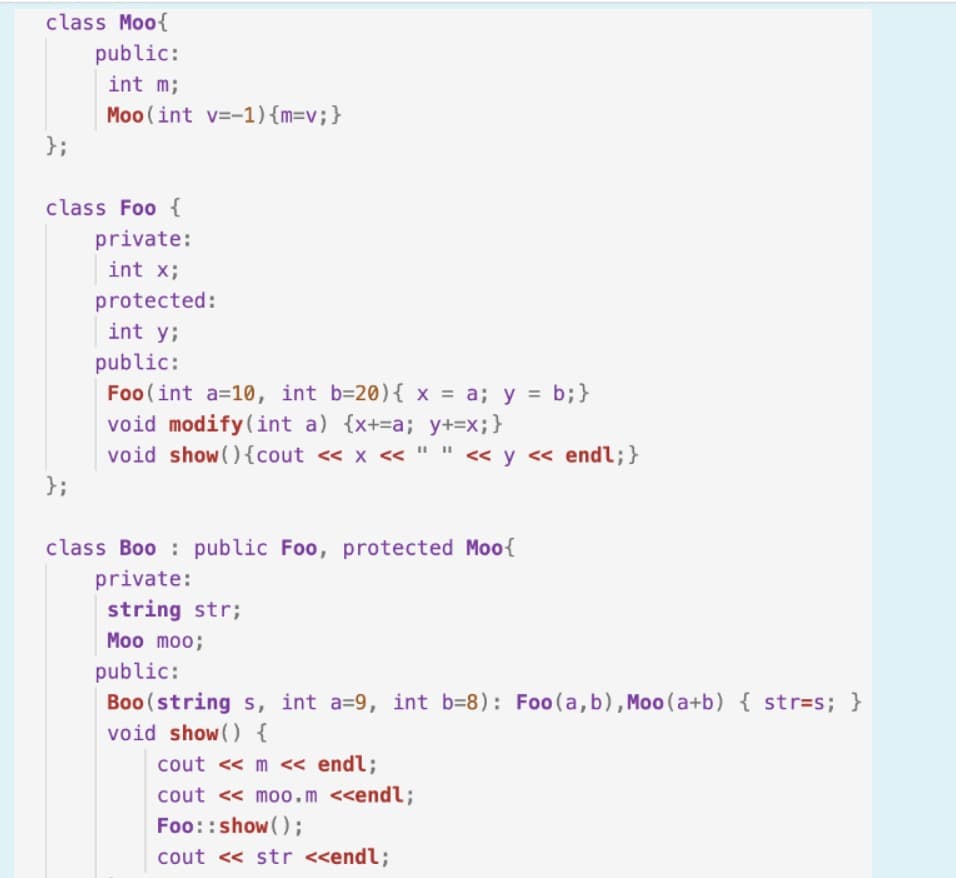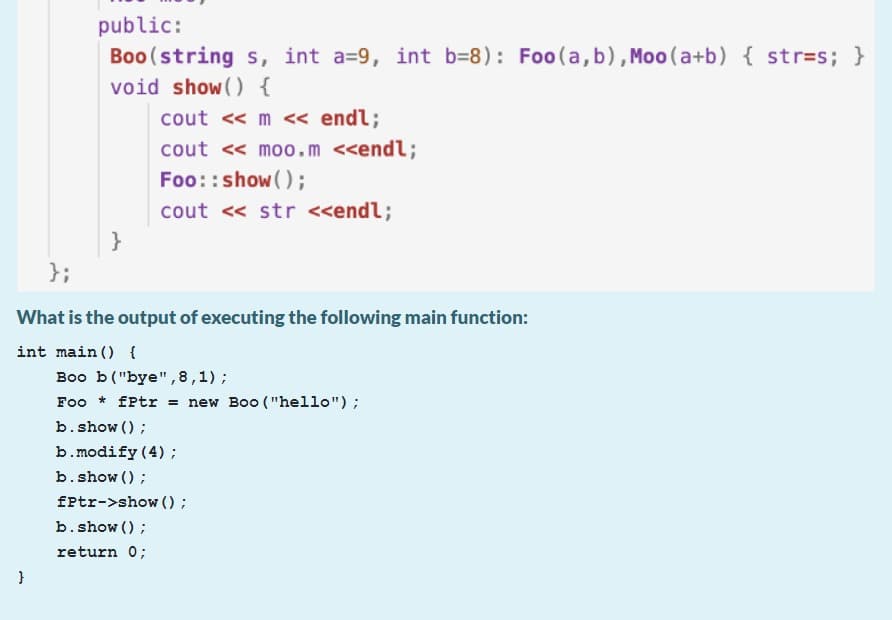class Moo{ public: int m; Moo (int v=-1){m=v;} }; class Foo { private: int x; protected: int y; public: Foo (int a=10, int b=20){ x = a; y = b;} void modify(int a) {x+=a; y+=x;} void show() {cout << x << " " « y <« endl;} }; %3D %3D %3D class Boo : public Foo, protected Moo{ private: string str; Moo moo; public: Boo (string s, int a=9, int b=8): Foo(a, b), Moo(a+b) { str=s; } void show() { cout << m << endl; cout << moo.m <
class Moo{ public: int m; Moo (int v=-1){m=v;} }; class Foo { private: int x; protected: int y; public: Foo (int a=10, int b=20){ x = a; y = b;} void modify(int a) {x+=a; y+=x;} void show() {cout << x << " " « y <« endl;} }; %3D %3D %3D class Boo : public Foo, protected Moo{ private: string str; Moo moo; public: Boo (string s, int a=9, int b=8): Foo(a, b), Moo(a+b) { str=s; } void show() { cout << m << endl; cout << moo.m <
Computer Networking: A Top-Down Approach (7th Edition)
7th Edition
ISBN:9780133594140
Author:James Kurose, Keith Ross
Publisher:James Kurose, Keith Ross
Chapter1: Computer Networks And The Internet
Section: Chapter Questions
Problem R1RQ: What is the difference between a host and an end system? List several different types of end...
Related questions
Question
Complete the code..

Transcribed Image Text:class Moo{
public:
int m;
Moo (int v=-1){m=v;}
};
class Foo {
private:
int x;
protected:
int y;
public:
Foo(int a=10, int b=20){ x = a; y = b;}
void modify(int a) {x+=a; y+=x;}
void show(){cout << x « " " << y << endl;}
};
class Boo : public Foo, protected Moo{
private:
string str;
Moo moo;
public:
Boo (string s, int a=9, int b=8): Foo (a, b), Moo(a+b) { str=s; }
void show() {
cout << m << endl;
cout << moo.m <<endl;
Foo::show();
cout << str <<endl;

Transcribed Image Text:public:
Boo (string s, int a=9, int b=8): Foo(a, b), Moo(a+b) { str=s; }
void show () {
cout << m << endl;
cout << mo0.m <<endl;
Foo::show();
cout << str <<endl;
}
};
What is the output of executing the following main function:
int main () {
Boo b("bye",8,1);
Foo * fPtr = new Boo ("hello");
b.show ();
b.modify (4);
b.show () ;
fPtr->show ();
b.show ();
return 0;
Expert Solution
This question has been solved!
Explore an expertly crafted, step-by-step solution for a thorough understanding of key concepts.
Step by step
Solved in 3 steps with 1 images

Recommended textbooks for you

Computer Networking: A Top-Down Approach (7th Edi…
Computer Engineering
ISBN:
9780133594140
Author:
James Kurose, Keith Ross
Publisher:
PEARSON

Computer Organization and Design MIPS Edition, Fi…
Computer Engineering
ISBN:
9780124077263
Author:
David A. Patterson, John L. Hennessy
Publisher:
Elsevier Science

Network+ Guide to Networks (MindTap Course List)
Computer Engineering
ISBN:
9781337569330
Author:
Jill West, Tamara Dean, Jean Andrews
Publisher:
Cengage Learning

Computer Networking: A Top-Down Approach (7th Edi…
Computer Engineering
ISBN:
9780133594140
Author:
James Kurose, Keith Ross
Publisher:
PEARSON

Computer Organization and Design MIPS Edition, Fi…
Computer Engineering
ISBN:
9780124077263
Author:
David A. Patterson, John L. Hennessy
Publisher:
Elsevier Science

Network+ Guide to Networks (MindTap Course List)
Computer Engineering
ISBN:
9781337569330
Author:
Jill West, Tamara Dean, Jean Andrews
Publisher:
Cengage Learning

Concepts of Database Management
Computer Engineering
ISBN:
9781337093422
Author:
Joy L. Starks, Philip J. Pratt, Mary Z. Last
Publisher:
Cengage Learning

Prelude to Programming
Computer Engineering
ISBN:
9780133750423
Author:
VENIT, Stewart
Publisher:
Pearson Education

Sc Business Data Communications and Networking, T…
Computer Engineering
ISBN:
9781119368830
Author:
FITZGERALD
Publisher:
WILEY